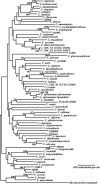Comparison between rpoB and 16S rRNA gene sequencing for molecular identification of 168 clinical isolates of Corynebacterium
- PMID: 15815024
- PMCID: PMC1081344
- DOI: 10.1128/JCM.43.4.1934-1936.2005
Comparison between rpoB and 16S rRNA gene sequencing for molecular identification of 168 clinical isolates of Corynebacterium
Abstract
Higher proportions (91%) of 168 corynebacterial isolates were positively identified by partial rpoB gene determination than by that based on 16S rRNA gene sequences. This method is thus a simple, molecular-analysis-based method for identification of corynebacteria, but it should be used in conjunction with other tests for definitive identification.
Figures

References
-
- Daneshvar, M. I., D. G. Hollis, W. S. Weyant, J. G. Jordan, J. P. MacGregor, R. E. Morey, A. M. Whitney, D. J. Brenner, A. G. Steigerwalt, L. O. Helsel, P. M. Raney, J. B. Patel, P. N. Levett, and J. M. Brown. 2004. Identification of some charcoal-black-pigmented CDC fermentative coryneform group 4 isolates as Rothia dentocariosa and some as Corynebacterium aurimucosum: proposal of Rothia dentocariosa emend. Georg and Brown 1967, Corynebacterium aurimucosum emend. Yassin et al. 2002, and Corynebacterium nigricans Shukla et al. 2003 pro synon. Corynebacterium aurimucosum. J. Clin. Microbiol. 42:4189-4198. - PMC - PubMed
-
- Funke, G., and K. A. Bernard. 2003. Coryneform gram-positive rods, p. 472-501. In P. R. Murray, E. J. Baron, J. H. Jorgensen, M. A. Pfaller, and R. H. Yolken (ed.), Manual of clinical microbiology. ASM Press, Washington, D.C.
-
- Jackman, P. J. H., D. G. Pitcher, S. Pelczynska, and P. Borman. 1987. Classification of corynebacteria associated with endocarditis (group JK) as Corynebacterium jeikeium sp. nov. Syst. Appl. Microbiol. 9:83-90.
Publication types
MeSH terms
Substances
Associated data
- Actions
- Actions
- Actions
- Actions
- Actions
- Actions
- Actions
- Actions
- Actions
- Actions
- Actions
- Actions
- Actions
- Actions
- Actions
- Actions
- Actions
- Actions
- Actions
- Actions
- Actions
- Actions
LinkOut - more resources
Full Text Sources
Other Literature Sources
Molecular Biology Databases

